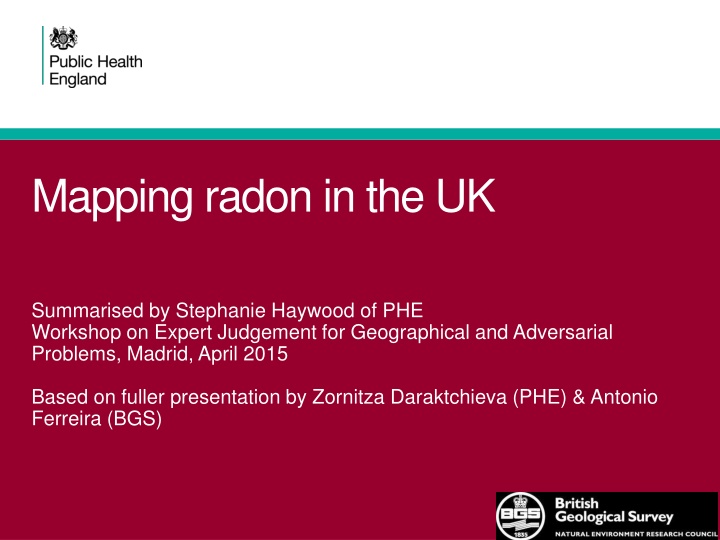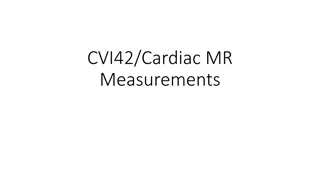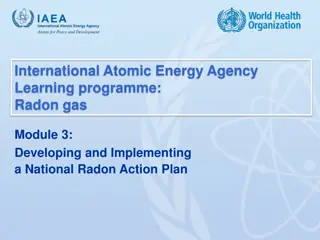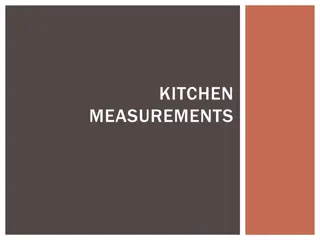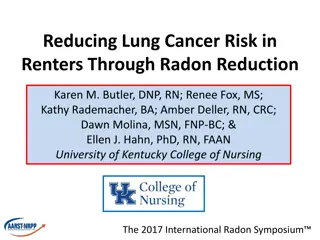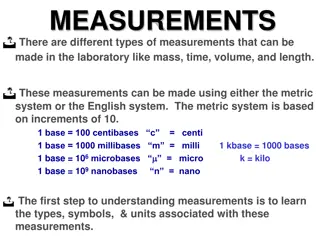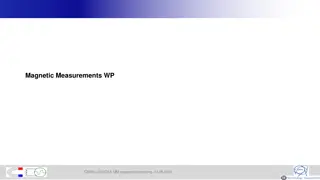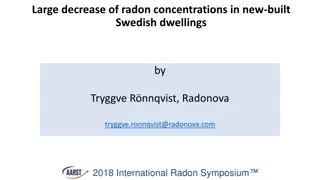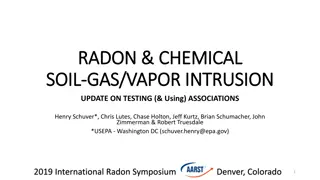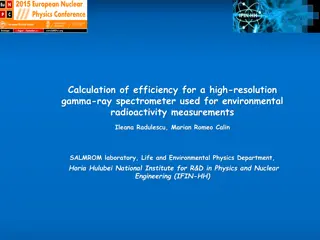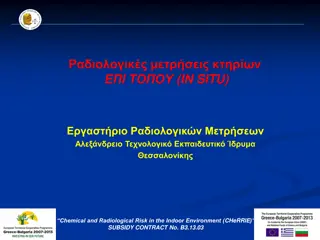Overview of Radon Levels and Measurements in the UK
Radon is a colorless, odorless radioactive gas that can seep into buildings through the floor, with indoor levels varying based on factors like geology, ground conditions, and human habits. Measurements involve sending detectors to homes for 3 months, considering occupancy factors for bedrooms and living rooms, and calculating annual concentrations with corrections for uncertainties.
Download Presentation

Please find below an Image/Link to download the presentation.
The content on the website is provided AS IS for your information and personal use only. It may not be sold, licensed, or shared on other websites without obtaining consent from the author.If you encounter any issues during the download, it is possible that the publisher has removed the file from their server.
You are allowed to download the files provided on this website for personal or commercial use, subject to the condition that they are used lawfully. All files are the property of their respective owners.
The content on the website is provided AS IS for your information and personal use only. It may not be sold, licensed, or shared on other websites without obtaining consent from the author.
E N D
Presentation Transcript
Mapping radon in the UK Summarised by Stephanie Haywood of PHE Workshop on Expert Judgement for Geographical and Adversarial Problems, Madrid, April 2015 Based on fuller presentation by Zornitza Daraktchieva (PHE) & Antonio Ferreira (BGS)
What is radon? Radon is a colourless, odourless radioactive gas formed by the radioactive decay of the small amounts of uranium that occur naturally in all rocks and soils. Radon can seep into buildings, through the floor. This is where we get most of our radon exposure. Indoor radon levels vary - every building contains radon but the levels are usually low. In some areas, homes may have higher levels, and the chances of a higher level depend on the type of ground. For instance, levels may be higher in parts of the country rich in granite, such as Dartmoor in Devon and Cornwall. 2
Why indoor radon levels vary Radon enters buildings because of the small pressure difference between indoor and outdoor Identical houses sitting next to each other could have different geology underneath and different ground conditions (eg cracks or disturbance) Occupants have different habits (ventilation, average indoor temperature, occupancy patterns) Mean outdoor temperature varies with season Wind direction can influence radon ingress Indoor levels vary between ~ 10 and 20,000 Bq m-3 3
Indoor radon measurements Two detectors are sent to peoples homes by post for 3 months Results are measured in two occupied rooms called bedroom and living room Occupancy factors are used, bedroom (0.55) and living room (0.45) Radon concentrations are calculated as an average of the two occupied rooms taking into account the occupancy factors The annual radon concentration is calculated from the above 3 months result using seasonal correction factors Large numbers of indoor radon measurements are available - more than 500,000 UK homes measured 4
Uncertainties in estimated annual radon concentrations Include: Measurement uncertainties eg detector response, procedures, human error Within house spatial uncertainties eg room usage, and extrapolation of two rooms result to the whole house Assumption of unchanging people behaviour 3 months measurement is extrapolated to annual result Measurement of one year is taken as a proxy for every year House structural changes (eg double glazing, extensions) that affect radon levels Contribution to indoor radon from radon outdoors and radon emanating from indoor building materials 5
Radon Affected Areas Radon potential is the probability of exceeding the Action Level (AL) set at 200 Bq m-3 Determined by an estimate of the probability of exceed the AL Six classes of radon potential: 0-1%, 1-3%, 3-5%, 5-10%, 10-30%, >30 % Radon affected areas are those where potential is >1% (advice is that homes in these areas should be tested) The other bands of radon potential support building requirements and targeting of publically funded projects 6
Want a map for decision-making on radon Although a large numbers of results are available, not every home is measured (currently ~2% of all UK homes) Different combinations of surface and bedrock geology will lead to different log-normal distributions of indoor air concentrations Need to combine indoor radon measurements with geology maps to show probability of exceeding the Action Level (AL) in the UK 7
DiGMapGB-50 geology is used to map GB Bedrock geology units Superficial geology units Map scale 4,500 grouped to 406 892 grouped to 10 1:50 000 England and Wales 4,800 grouped to 138 189 grouped to 10 1:50 000 Scotland 8
Methodology Uses one of the largest radon data sets in the world . . in combination with in-depth UK geology data Takes account of the number of measurements available in a local area of contiguous geology Final map also reflects uncertainties in local geological boundaries (most are derived from physical maps) uncertainty in allocated house "position" 9
Published indicative maps England and Wales Scotland 10
Web-sites http://www.ukradon.org/information/ukmaps/englandwales https://publichealthmatters.blog.gov.uk/2015/03/20/five-facts-every- home-owner-should-know-about-radon/ http://www.ukradon.org/information 11
